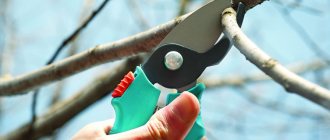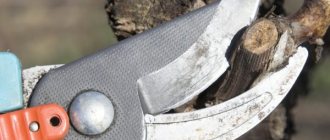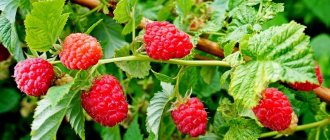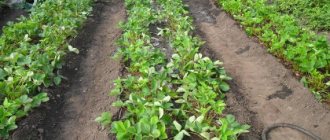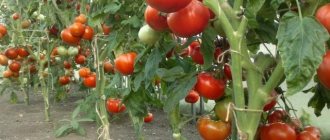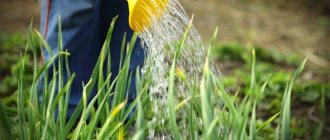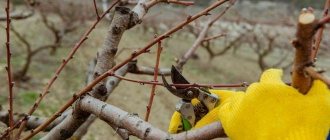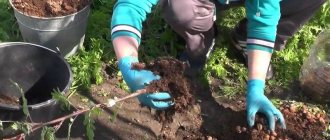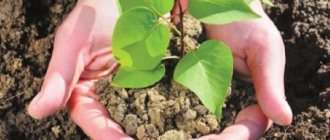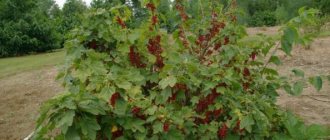Category: Growing and care Reading time: 9 min · Views: 3,440
The bright fruits of rowan attract with their beauty. Many summer residents plant these frost-resistant shrubs on their plots. There are many types and varieties of garden rowan, among which chokeberry is also popular. How to prune chokeberry in the fall? How is rowan pruning useful, and how to do it correctly?
How to prune rowan trees in summer
Young, recently planted mountain ash is pruned mainly in the spring immediately after planting to form a crown. Old rowan trees can be pruned in the summer, and the cuts heal faster and there is less risk of infection in the bark and wood. Summer pruning of rowan brings better results than in spring.
It is recommended to cut rowan in good weather, on a dry and sunny day. Since in sunny weather, rowan is less susceptible to fungal diseases.
Timing for pruning.
Depending on the age of the tree, as well as the purpose of pruning, the timing of pruning is different.
Thus, he recommends pruning young rowan trees immediately after planting; first of all, this is important for the formation of the crown.
It is preferable to prune mature trees in the summer season. In this case, the cuts made are healed much faster, which reduces the risk of infection of rowan with various viruses and infections that affect wood tissue and tree bark. Practicing gardeners also note that summer tree pruning is more effective than when it is carried out in the spring.
Experts advise pruning rowan trees in good weather, on a warm and dry day, since there is a high probability of avoiding infection of the tree with fungal infections, which spread quite quickly in conditions of high humidity.
After pruning, you must immediately treat the sections using garden varnish or water-based paint. Some gardeners additionally apply fungicide solutions to the cuts. If the cut is not treated, this is fraught with infection by various infections, which can subsequently provoke necrosis of the tree and its death. In order for the cut to tighten faster, it is important that it is even and smooth.
Most often, the following scheme is used for pruning mountain ash. The lower tier of branches is cut so that the height of the trunk is 30 - 60 cm. Pruning is carried out to the ring, that is, almost to the base, or, more precisely, to the influx of a ring-shaped shape. If necessary, trim the skeletal branches, subordinating them to the conductor and aligning them with other branches. The central conductor of the tree should rise 25-30 cm above the upper tier of branches.
Annual pruning of a tree involves cutting off unnecessary shoots, young growth, and removing old branches that are no longer fruit-bearing, but only hinder the development of the tree by taking away nutrition.
In the autumn season, rowan requires more care, which involves taking preventive measures to prevent diseases, and also aimed at increasing productivity in the coming season. Rowan, like most trees, grows more actively in the spring, and in the summer its growth slows down a little. Starting in September, mountain ash gradually enters a state of dormancy, which finally occurs in November. In the fall, it is not recommended to fertilize rowan berries with nitrogen-containing fertilizers, since their effect is aimed at the growth of green mass, and before the imminent start of the dormant period, this is of no use. During this period, pruning rowan trees is also not advisable, since such a procedure will also promote the growth and development of the tree. In addition, cuts made during autumn pruning do not have time to heal quickly, and the tree may freeze.
When the winter is warm and severe cold is no longer expected, you can start pruning rowan trees as early as February. However, in this case it will be very moderate and gentle. Two or four year old trees can be subjected to this pruning. It is better to leave pruning of younger as well as older trees for late spring - early summer. In a number of regions, towards the end of winter, they also begin pruning other fruit trees, such as apple and pear trees, and after a while apricot, plum and peach are pruned.
Some varieties of rowan are very vulnerable to various diseases, so it is recommended to prune them exclusively in summer.
Rowan pruning: annual pruning
The most common scheme for pruning rowan
To ensure the healthy development of a tree with abundant fruiting, rowan is pruned every year. Pruning, carried out according to all the rules, eliminates unwanted young shoots and old branches that impede the development of the tree, or simply do not bear fruit. Thinning young plants gives the desired shape and stimulates the germination of new strong shoots. It is recommended to divide rowan pruning into two stages:
- cutting before wintering;
- pruning during the growing season.
Bush formation and maintenance sanitary pruning
During the formation of the shrub, carefully monitor its crown.
After planting a young chokeberry seedling, transplanted or grown from seed, the current year's growth does not need to be shortened. In the first year, all the plant’s forces are aimed at adapting and developing the root system.
In subsequent years, when young chokeberry shoots begin to appear, the formation of the bush needs to begin. It is carried out according to the following scheme:
- Three or four of the strongest and most promising branches are left from the shoots, cutting off all other shoots at soil level, as well as those that will grow in the summer.
- For the next four years, the procedure is repeated, leaving 3-5 young shoots and cutting out all unnecessary ones. Thus, in the sixth year, the base of the chokeberry bush will be about 10-12 branches of different ages.
- Then only sanitary cutting is carried out - weak, broken or frost-damaged branches are removed. The root shoots are cut out and the density of the crown is controlled.
- Around the seventh or eighth year, gradual rejuvenation of chokeberry begins. Branches older than seven years are cut off at the very base, leaving no stumps, which can become a breeding ground for infections and pests.
- To replace the removed branches, in the spring they leave such a quantity of strong, healthy shoots, which after a few years will become the basis of the crown.
- In subsequent years, the procedure for replacing branches is repeated, thus achieving constant rejuvenation of chokeberry, without loss in yield.
During the formation of the shrub, carefully monitor its crown. Excessive branching inevitably leads to thickening of chokeberry, and lack of sunlight is the main reason for the decline in yield. Remove all unnecessary shoots that grow inside the crown, because they will be of no use anyway, and nutrients will be wasted.
Pruning rowan in autumn
Rowan requires multiple treatments in the fall, designed to minimize the risk of disease and to prepare the plant well for winter in order to obtain a good harvest next year. Rowan, like many trees, grows most intensively in the spring, and growth occurs more slowly in the summer. Between September and November, the rowan tree should enter a state of winter dormancy and gradually harden before the onset of frost.
In autumn, nitrogen fertilizers are not applied to rowan trees, which stimulates plant growth. It is also not recommended to prune during this period, as it has a similar effect. However, there are exceptions to any rule.
Tips for gardeners.
If the rowan has stopped growing, then in the spring, before the sap begins to flow, the top of the crown should be partially cut off. This pruning will encourage the growth of side branches. In addition, it is necessary to prevent the tree from forming inflorescences and fruits, so that all nutrients are directed towards its growth.
In some cases, regular feeding does not bring the expected effect. This can happen when the tree has a weak root. Experts recommend, if possible, digging up the tree and cutting off part of the root. After this, the roots will begin to grow, and a powerful and branched root system will be able to absorb a larger volume of necessary nutrients and elements.
If there is a need, on the contrary, to stop the active growth of a tree, then it is enough to carry out summer pruning of rowan.
In the spring, pruning of rowan, like other fruit trees, is carried out strictly before the sap flows and the buds begin to swell.
Pruning in winter
Pruning rowan in the 2-3rd decade of February
Pruning rowan can begin in February, provided that severe frosts are not expected. They begin to prune two to four year old trees, which are more resistant to February frosts, and young trees, more sensitive to low temperatures, are best left until mid-late March. At the end of winter, you can start by pruning pear and apple trees. A little later, apricots, peaches, plums and nectarines are pruned. It is worth noting that young trees are recommended for winter pruning, and for older mountain ash, summer would be a more suitable period, as this will reduce the risk of infections.
Certain varieties of rowan, which are most susceptible to bark and wood diseases, are pruned only in summer. Or trees are pruned after the harvest is harvested. Winter tree pruning should be done sparingly without causing the trees to grow too much and risk too much infection.
Tip #2. It is not recommended to prune trees in late autumn, because the wounds after cutting do not have time to heal before winter, and can cause the mountain ash to freeze.
How to feed rowan
Starting from the third year of life, young plants must be fed with mineral fertilizers.
The most effective is considered to be fertilizing three times: in spring, summer and after harvest. Fertilizers are applied shallowly, slightly digging up the soil, after which the rowan is watered abundantly.
Rowan trees combine surprisingly well in plantings with pines, spruce, fir and most deciduous trees - they look harmonious against the background of linden and ash trees, poplars and willows.
Almost all types of rowan are appropriate in plantings of spirea, barberry, maple, roses, honeysuckle and many deciduous shrubs. They also occupy a worthy place in group plantings, both foreground and background, in hedges and serve as a backdrop for herbaceous perennials.
Rowan is fed three times per season
Pruning rowan after planting
Young mountain ash should be thinned out well after planting, as it usually has too many shoots growing at an acute upward angle. If the rowan tree is not pruned in the first year after planting, the thickened branches will stretch upward. The branches will be thin and fragile. In the future, this will also complicate the formation of the tree crown.
Before starting the first pruning after planting, the thickest and tallest branch in the middle of the crown is selected; it will be the main trunk. The trunk should be vertical and dominate the side shoots. It is not pruned at all in the first year. Other side branches are cut very short, leaving 1-3 buds from the main trunk. These branches will develop next spring. It is also necessary to remove all shoots at a distance of 40 cm from the ground, this will increase resistance to diseases and parasites.
Varieties of chokeberry
These delicious juicy berries provide great health benefits. From Latin the name aronia melanocarpa is translated as a healthy berry. In folk medicine, berry infusion is used to prevent atherosclerosis and lower blood pressure. Chokeberry bushes can serve as both a garden decoration and a hedge.
There are several varieties of this amazing shrub:
- ruby;
- nero;
- black-eyed;
- Viking;
- Hugin.
But the most common variety of chokeberry is Aronia Michurina. It is resistant to frost down to -40C, unpretentious to soil fertility, and tolerates pruning well. The bushes grow up to 3 meters in height and produce large, sweet and sour black fruits with a bluish coating. The fruits have a slightly flattened spherical shape.
Cutting young rowan
Over the next four years after precipitation, young mountain ash is pruned very sparingly, shaping the crown of the tree and cutting through it from excessive density. To do this, after the harvest is harvested, cut out:
- old branches;
- young shoots lowered to the ground;
- branches growing into the center of the tree;
- shoots that can compete with the central trunk;
- damaged branches;
- branches with disease symptoms.
For normal development of rowan, on average, it is enough to reduce about 1/5 of all shoots. Sometimes, secondary vertical shoots develop faster than the central trunk, in which case they can be left for replacement in subsequent years.
Crown formation
Chokeberry is pruned in autumn and spring, before sap flow or after it stops, but while the shoots are still flexible. Many gardeners, to give the tree the desired shape, prefer April or the end of March, until the buds swell. Elongated shoots are cut off, branches that are frozen or broken off during the winter are removed. But even in this case, the main work is done in the fall. Diseased branches with worn-out wood or damaged bark are cut off, and stumps in the circle around the trunk are uprooted. Wood not covered with bark, especially wood that is rotting, is a favorite wintering place for pupae of insect pests. They should not create ideal conditions.
Pruning a mature tree
Maximum effect after pruning in summer.
Pruning old mountain ash that is older than 5 years can be more intense. In such trees it is necessary to cut out the side branches, rejuvenating the tree. Young shoots bear fruit better and are more resistant to frost, pests and diseases. The rejuvenation procedure is recommended to be carried out once every two years.
Shortening the old tree branches stimulates the production of a large number of new shoots. For this purpose, old branches are shortened by about 1-1.5 meters. 1/3 of all old branches are pruned so as not to weaken the fruiting of the rowan.
When pruning old mountain ash, branches that are more than 4 years old must be completely removed. Only young branches and annual shoots remain on the tree. All old branches are removed with the exception of the central trunk. Old side branches are cut off at a distance of several centimeters from the trunk. All these manipulations will stimulate the growth and development of young shoots, which in turn will delight you with a rich harvest.
Types and patterns of pruning
When pruning chokeberry, it is important to take into account the age and condition of the plant, and the total number of fruiting branches.
Formative
In the first year of growth, a young chokeberry seedling does not need cleaning or shaping. During this period, the plant actively grows its root system; pruning traumatizes it.
In subsequent years, bush shaping is carried out according to the following scheme:
- 2nd year - select 3-5 promising branches and cut them at the same level at a height of 40-50 cm;
- 3-4 years - select 3-5 strong branches from the new root growth and cut them at the same level;
- 5-6 years - 3-5 branches are added from the new shoots and aligned with the rest, forming a crown of 10-15 strong fruit-bearing branches.
In subsequent years, rowan trees are regularly pruned so as to leave 10-15 fruit-bearing branches of different ages. To do this, remove all shoots over 6-7 years old and replace them with young, nearby branches.
When shaping the crown, it is extremely important to create a shape so that the crown from base to top receives the same amount of sunlight and heat, and the root zone is well ventilated. This will create optimal conditions for the establishment of a large number of fruit-bearing buds, prevent infection with fungal diseases, and make caring for the plant easier.
Rejuvenating
Anti-aging pruning is carried out on very old plants 10-15 years old. To do this, all branches are cut off right at the root in the fall. Next year in the spring the plant will produce many new young shoots, which will begin to bear fruit at the age of 2-3 years.
From the year following radical pruning, they begin to form the bush in the traditional way.
Sanitary
Sanitary pruning of chokeberry is carried out exclusively in the fall. The bush is inspected and weak, diseased, deformed, broken branches are cut out. Side shoots from skeletal branches are also removed during sanitary cleaning of the bush.
Important! After pruning chokeberry, no stumps are left on the bush to avoid damage to the cuts by bacteria and pests.
Stages of cutting rowan
Young mountain ash stretches upward strongly, using resources for growth rather than fruiting. Therefore, young trees are limited in their growth by crown formation. Dead and damaged branches that intersect and grow towards the trunk are cut out from all trees. Particular attention is paid to trees older than four years.
Table 1. Stages of cutting old mountain ash
| Stage | Principles |
| Pruning large branches | The work begins by cutting out the thickest branches of the crown to ensure good penetration of sunlight into the tree. Sometimes it is necessary to remove the entire upper part of the rowan crown to reduce its height. Low trees are easier to process and protect from diseases and pests, convenient to harvest and care for them |
| Cutting small branches | After the first stage, branches that intersect, burst, shade and grow close to each other or inside the crown are pruned. Such pruning is not dangerous and does not harm the tree, and after the appearance of new leaves and active growth in the summer months, the rowan quickly becomes quite lush |
Why does rowan need pruning?
Chokeberry is a perennial shrub with edible and healthy fruits. Every year it grows a large number of new branches, which stretch out, preventing new shoots from growing. It is dark inside the crown; due to lack of light, the fruits develop poorly. If pruning is not done, then after 3-5 years the fruiting will decrease several times. The berries will ripen only on the outer branches; there will be none inside the crown. Ripe fruits will become small and sour, as the plant will spend all its energy on growing branches. Old and wild plants may not produce fruit at all.
An unpruned bush does not look neat. Every year the outer branches become thinner. To form the crown and make it decorative, the bush is pruned annually. The procedure is done in spring or autumn, this helps to rejuvenate the bush. Fruiting in chokeberry occurs 5-7 years after planting. During the first 2-3 years the bush develops; pruning is not recommended.
The density of the crown leads to infection of the plant. Fungi settle in the shady part of the crown, where moisture is always retained. Rowan can be inhabited by insects that harm it and spread diseases. With a large number of branches, new shoots stop forming and developing.
Attention! It is not recommended to plant bushes close to each other, since rowan has many basal shoots that grow quickly and also need to be removed.
Pruning according to the principle of a dwarf pyramid
The main purpose of pruning newly planted trees is to restore balance between the roots and the above-ground part. When trees are uprooted in a nursery, the root system is damaged and, therefore, by reducing the crown, the correct conditions are restored to obtain water and nutrients from the soil in quantities that will stimulate bud development. Another important goal is to:
- give the appropriate crown shape to young seedlings;
- form a guiding vertical main shoot;
- prevent the formation of sharp angles between the trunk and branches (shoots growing at an acute angle easily break under the weight of the fruit);
- prevent thickening of the crown of the trunk.
Heavy pruning of newly planted trees reduces the number of flower buds and, in turn, reduces fruiting the following season. Branched biennial rowan trees growing in fertile soil with irrigation are pruned minimally. Instead of pruning, branches growing at an acute angle are simply arched and secured. This allows you to get the first harvest the following year after planting. The exception is weaker trees planted on poor soils without the possibility of regular watering. The first fruits from this rowan tree are obtained a year after planting.
One of the popular ways of forming a rowan is pruning according to the principle of a dwarf pyramid or spindle - a crown similar to a Christmas tree. Also, the crown spindle is recommended for apple, pear, cherry, plum, cherry, peaches, walnuts and hazel. Pyramid pruning reduces the size of trees and allows for denser plantings.
Pruning begins by shortening the top of the trunk, leaving about 40 cm to the nearest branch. The cut should be placed diagonally above the bud. Next, branches that are located at a distance of 50 cm from the ground are cut. The remaining side shoots remain, with the exception of those that are severely damaged and interfere with the irrigation system. Then the side shoots are reduced to one third or one quarter of their length.
Different pruning methods for 1 year old, 2 year old and 4 year rowan trees
Another method of dwarf pyramid pruning is to stimulate the growth of new side shoots. The top remains about 15-20 cm to the first lateral branch, and all shoots at a height of up to 50 cm are removed from below. Very young rowan in the first year after planting is pruned at a height of 70-90 cm to stimulate the growth of lateral shoots.
At the turn of May and June, pegs are driven around the rowan tree, to which the side branches are tied to form the correct angle. From the second half of July to the end of August, young shoots 40-50 cm in length are loaded with an additional weight of 200-300 g. The tree formed in this way can withstand any load and delights with a rich harvest.
The angle of inclination of young branches is changed with the help of weights, and thicker ones are tied to the ground.
Where to cut
Proper pruning has a significant impact on the rate of wound healing and thus reduces the risk of contracting an infectious disease. The surface after cutting should be as smooth as possible, and inclined towards the root at an angle of 45ºC.
Cutting tool
Before you start pruning rowan, like any tree or shrub, you should prepare the appropriate tools. Thin branches can be removed using hand pruners; thick branches are best cut using a saw. Thick branches are first sawed from below, and then sawed from above. This prevents lifting and chipping of branches and bark.
Small branches are cut into a ring with sharp pruning shears
Processing slices
To prevent rowan diseases from bacteria getting on the cuts, pruning is carried out only on dry and sunny days, at air temperatures above 0 C. Immediately after pruning, the wounds are treated with a protective paste. One of the most commonly used cut ointments for trees is Funaben 03 PA. Also, wounds on mountain ash can be lubricated with white dispersion paint with the addition of fungicides:
- Topsin M 70 WP
- Benlate.
Cuprate 50 WP is also used to lubricate wounds on trees. These drugs accelerate wound healing and protect trees from drying out and disease.
Common rowan: cultivation and care
Rowan is very beautiful both during flowering and with clusters ripened on the branches. The berries last a long time on the tree, are not afraid of frost, and are tasty in the form of juices, jellies, jams, marmalades, marshmallows, or simply ground with sugar. You can even prepare homemade medicine using them. Therefore, many gardeners are interested in having at least one rowan tree on their plot. It is a classic of the Russian landscape. And the ancient Slavs attributed the ability to rowan to protect the farmstead from all evil spirits.
Planting and growing mountain ash.
It is possible to grow rowan in the most ordinary soil, but in light soil the tree will grow worse and produce less yield than it could. It is best to plant rowan in the fall. A planting hole measuring 60 x 60 cm is filled with fertile soil, about 5 kg of peat compost or humus, 100 g of potassium fertilizer and 200 g of superphosphate are added to it. The easiest and fastest way to get a seedling is to graft a bud or cutting onto a seedling of any type of rowan. This can also be done using layering, grafting, seeds and root suckers.
You can grow rowan from freshly picked berries, which are picked when they begin to turn brown. They need to be freed from pulp. The seeds must remain moist until autumn sowing. Make shallow grooves in the soil, cover them with humus, deepening them by one and a half centimeters. Plant in a well-lit area. When the seedlings grow up, transplant them to a permanent place. During the care process, form a trunk up to 80 cm in height and plant a couple of cuttings into its upper part, from which you will later form a crown. The technique of grafting a rowan tree is done in the same way as on an apple tree.
Rowan care, crown formation and pruning.
After this, all care comes down to weeding the weeds in a timely manner, removing rootstock, applying fertilizers, watering and loosening the soil. It would also be a good idea to mulch the tree trunk circle (cover it with straw, pine needles, dried grass). Before fruiting begins, a puddle should form in the tree trunk circle from watering - this is the advice of experienced summer residents. Layering is done if the mother tree has a low-standard shape, which makes it easy to bend the branches to the ground. Grafted plants will produce fruits in 2-4 years. It is advisable to plant or graft at least a couple of varieties so that they cross-pollinate. Pruning is done to ensure even illumination of the tree, therefore, for a larger harvest. Since the crown of the rowan tree is pyramidal, and the branches extend from the trunk at an acute angle, this has a bad effect on their strength. Therefore, when forming the main skeletal branches, try to bring them out at an obtuse or right angle.
Pruning is carried out in early spring before the buds swell. In young trees, shoots are slightly shortened to the outer bud, shoots that extend at an acute angle and excess ones are removed. For varieties that bear fruit on last year's growth, the branches are thinned out and shortened slightly. If the growth is weak, rejuvenating pruning of two or five year old wood will help. Rowan, onto which several varieties have been grafted, have their semi-skeletal branches shortened, and in the most productive years the ringlets (the smallest branches) are thinned out. Rowan shoots grow quite quickly; almost all of them ripen by winter.
Varieties of red rowan
There are many varieties of red rowan, but at home the sweet-fruited species are more interesting for growing:
The Russian or liqueur variety was bred by Michurin - he crossed the common forest rowan with the chokeberry. It has high winter hardiness and productivity. Large fruits up to 15 mm in diameter, almost black. Mainly used for making liqueurs, tinctures and jams.
Rowan is very common throughout Central Asia and grows in Crimea. It is distinguished by very large green fruits the size of plums. The tree is very tall - almost 15 m in height.
Variety Nevezhinskaya. The tree is tall up to 10 m with a wide pyramidal crown, durable. It has dark gray branches and trunk that darken with age. It has oblong-pointed large buds and elongated, red 5-sided fruits. The taste is good, no bitterness is felt. Ripens in August-September.
Variety Pomegranate. Obtained as a result of crossing rowan with hawthorn. The height of the tree is up to 4 m. It has a very sparse crown. The faceted, pomegranate-colored fruits have a slightly tart, sweet taste and become ripe in August–September.
Variety Titan. Received in 1916 by I.V. Michurin. He pollinated a hybrid rowan seedling with pollen from various varieties of apple and pear trees. The tree is tall, almost 10 m tall, with a dense pyramidal crown. The fruits are faceted red, juicy. The taste is sweet and sour. High-yielding winter-hardy variety.
Ruby variety. Obtained as a result of pollination of rowan with pollen of different varieties of pear. The fruits are sweet and sour, faceted, dark red.
Most rowan varieties are self-sterile, so for a good harvest it is advisable to plant several different varieties for cross-pollination. You can agree with your neighbors and plant trees of different varieties on both sides of the fence. If you are planting only one tree, graft a couple of other varieties into the crown.
Harvesting
Rowan berries on the branches last a long time. It is better to harvest bitter-fruited varieties after the first frost so that the astringency goes away. The berries of sweet-fruited varieties are removed immediately when ripe so that birds do not peck them. You can tear off low-growing trees with your hands, and cut off brushes from tall ones with loppers. If the berries are picked after frost, they can be stored all winter in bunches in a cold place or frozen. And the fruits collected before frost must be cleared of leaves, branches and stalks, sorted, air-dried and dried in the sun or in the oven. About 20 kg of fruits are usually collected from one tree.
The most common mistakes made by amateur gardeners when pruning rowan trees
Error 1. Not removing vertical or growing shoots at an acute angle. Secondary branches will compete with the main trunk, absorbing almost all nutrients, which slows down the development of rowan as a whole.
Error 2. Slices remain unprocessed. Fresh cuts must be treated with paint with the addition of a fungicide. As a last resort, you can cover it with wet black soil.
Error 3. When forming a rowan in the form of a bush, many vertical shoots remain. The optimal number for a bush is 3-5 main shoots.
